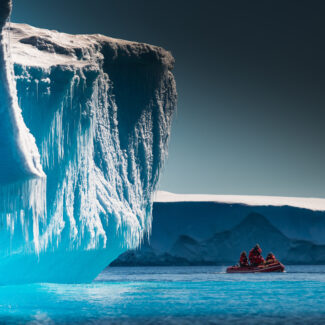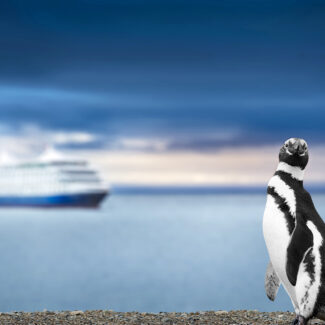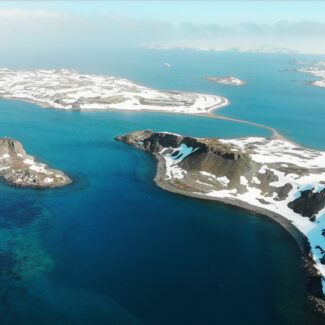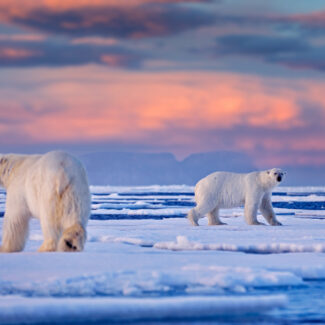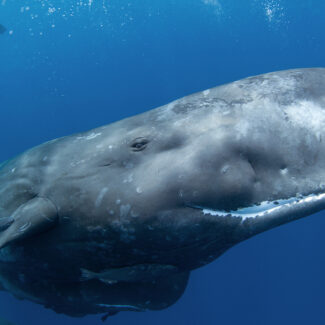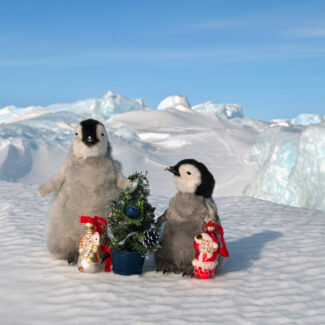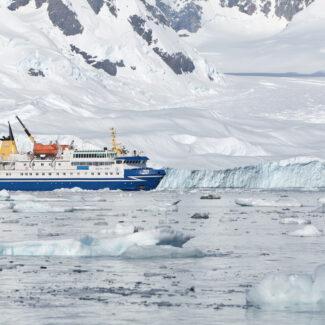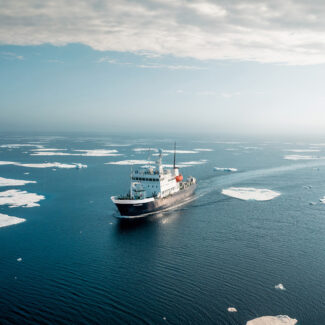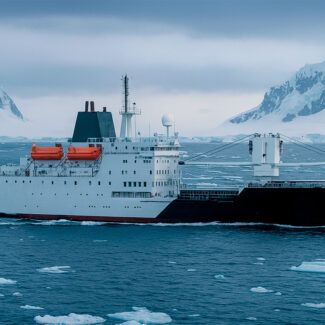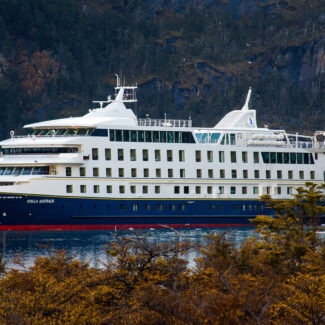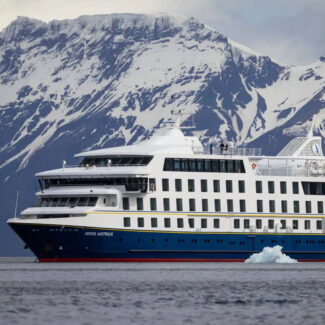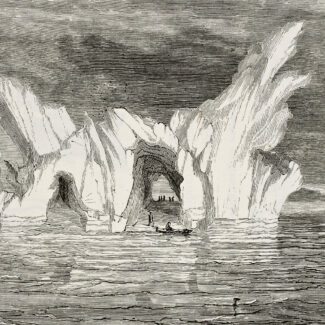A Cruisegoer's Guide To The Seals Of The Arctic & Sub-Arctic
Marine mammals are a noteworthy part of the Arctic ecosystem, to say the least—and top attractions for cruise-going wildlife-watchers, photographers, and general-purpose ecotourists. And among those marine mammals, pinnipeds are definitely some of the stars of the show.
The biggest of these Arctic pinnipeds is the iconic walrus, that hulking, tusked, wrinkled, and mustached sea-beast restricted to far northern waters. We’ve got an entire article dedicated to this magnificent and unique marine mammal that you can check out right here.
The most diverse of the Arctic pinnipeds, meanwhile, are members of Family Phocidae: the true, or earless, seals. Some members of the eared-seal family—Family Otariidae, the sea lions and fur seals—inhabit sub-Arctic waters.
Seals in the Arctic Ecosystem
Seals are vital components of the Arctic’s marine ecosystem, serving as important high-level predators of a collectively broad variety of fishes, crustaceans, cephalopods, and other generally small prey.
And seals themselves are critical sustenance for several of the Arctic’s top predators, namely polar bears, sleeper sharks (the Greenland and Pacific sleeper sharks), and orcas (killer whales). Particularly those species that range southward into sub-Arctic and northern temperate waters are also exposed to a variety of other predators: Great white sharks are big-time hunters of gray and harbor seals, for example, and brown bears and wolves—even coyotes—will happily take hauled-out seals on an opportunistic basis.
As both clever predators and a key food source, seals play an essential role in the intricate balance of the Arctic ecosystem. The health of the entire food web relies on their survival.
Ice Seals of the Arctic
Scientists classify a number of true seals in both the Arctic and Antarctic as “ice seals” or “pack-ice seals,” so-named because of their close association with sea ice. All show significant morphological and behavioral adaptations to an ice-based lifeway, and they tend to whelp directly on sea ice. The yearly movements of these seals are therefore synced with the annual patterns of sea ice, the animals commonly shifting south in winter as the ice expands and northward in spring and summer as it retreats poleward. That said, some ice seals spend extended periods of time pursuing a pelagic lifestyle in open water outside of the breeding, pupping, and molting periods.
In the Northern Hemisphere, six ice seals have primarily Arctic and sub-Arctic ranges. Let’s get to know them!
True masters of the ice, these Arctic seals are a special sight for cruisegoers, a reminder of the unique life that thrives in these icy, remote waters.
The Bearded Seal
Biggest of the Arctic ice seals (though outweighed by a few Antarctic ice seals), the bearded seal may approach 1,000 pounds, with females often a little bit heftier than males. The species gets its name from its luxurious white whiskers, or vibrissae, which it employs in its seafloor foraging after primarily bottom-dwelling invertebrates such as crabs, whelks, and clams as well as sculpin, cod, and other fishes.
Mainly a solitary animal, the bearded seal prefers relatively shallow waters over continental shelves, and undergoes annual movements shadowing the expansion and retraction of sea ice. Its circumpolar range includes the Arctic Ocean and extends south into sub-Arctic waters such as the Bering Sea, Sea of Okhotsk, and the Labrador Sea.
Bearded seals are known for their varied vocalizations, which include eerie moans and intricate twitterings mainly issued during the breeding season and which may be heard a dozen or more miles away.
The bearded seal’s long, whiskered snout gives it its name—but its whiskers are more than just a beard. They are highly sensitive feelers for foraging on the seafloor.
The Ringed Seal
The ringed seal’s at the opposite end of the Arctic ice-seal size spectrum from the bearded seal, growing to about five feet long and 200 pounds. This is the most numerous seal in the Arctic, with a global population reckoned at north of two million. It’s also the number-one prized food of the polar bear in most parts of that mighty carnivore’s range.
Ringed seals earn their name due to the white circles mottling their dark pelts, which almost call to mind (though not in coloration) the blotchy spots of a jaguar. They are stubby little seals with powerful foreclaws they use to haul themselves up onto ice, open breathing holes in ice cover, and dig the snow lairs in which they rear their vulnerable pups. They feed mainly on various crustaceans, cephalopods, and small fishes.
The circumpolar ringed seal is mainly an Arctic and sub-Arctic creature, but it does range comparatively far south, into the Sea of Japan for example and with a unique subspecies (one of five described) occupying the Baltic Sea. Notably, there are two populations—each its own subspecies—restricted to freshwater lakes: one in Finland’s Lake Saimaa, the other in Russia’s Lake Ladoga.
Often a main course for polar bears, the ringed seal is a vital link in the Arctic food chain, providing essential nourishment to the region’s top predator.
The Harp Seal
The harp seal, also known as the saddleback seal, gets both those common names from its unique adult coat pattern; at birth, pups are snowy-white and called “whitecoats.” Ranging from the eastern Canadian Arctic into Russia’s Barents and White seas, harp seals are found in three distinct populations, each with its own pupping ground. They are standout divers, capable of plunging down to 1,300 or so feet in pursuit of their notably varied diet of fish and invertebrates.
We’re only summarizing this charming seal here, on account we have an entire article devoted to the “saddleback”: “5 Harp Seal Facts You May Well Harp On About to Your Friends.”
Harp seals are known for their incredible annual migrations across the Arctic, with millions of seals traveling together to give birth on the sea ice—a sight to behold!
The Spotted Seal
The pretty spotted seal, also sometimes called the larga seal, looks quite similar to the closely related harbor seal with its sausage-like body and speckled, gray-white hide, and the two overlap in summer range. But the spotted seal, unlike the harbor seal, is a true ice seal, dependent on sea ice and inhabiting a mainly Arctic and sub-Arctic North Pacific geography, though it also extends into temperate waters—including into the Sea of Japan as well as the Yellow Sea, where the species is China’s only breeding pinniped (and classified as endangered in that country).
Feeding on fish such as pollock and herring as well as crustaceans, the spotted seal, which grows to about five feet long and 200 or more pounds, is a shallow-diver associated with continental-shelf habitat. It’s unique among its kind in the fact that family groups of three—an adult male, female, and pup—commonly associate during the breeding season.
Named for their beautiful mottled coats, spotted seals are a common sight in the sub-Arctic, often seen resting on rocky shorelines as they travel the North Pacific.
The Ribbon Seal
Among the most beautiful of all pinnipeds, the ribbon seal earns its name on account of its boldly contrasting pelage, which consists of white or pale bands set against a base of dark-brown or black. Like more than a few ice seals, pups are born white-coated, with the ribbon pattern gradually developing in juveniles across successive molts.
Ribbon seals are a North Pacific and Arctic Ocean species, with a range anchored by the Sea of Okhotsk and the Bering Sea, primary breeding areas, and extending north into the Chukchi and Beaufort seas. They haul out on sea ice to whelp, breed, and molt, but otherwise appear to spend much time in the open ocean. Their rather blasé behavior when approached while hauled out suggests they aren’t as heavily preyed upon by terrestrial predators such as polar bears as some other ice seals.
Adults grow to five or six feet long and weigh up to 330 or so pounds.
The Hooded Seal
The title for most eccentric-looking Arctic seal must go to the hooded, which gets its name from the inflatable head sac of the male. Used to attract mates and ward off rival males, the sac gets some backup in the display department as well from the male’s nasal septum, which can be extruded out of a nostril and looks very much like a pinkish-red balloon. Males, which may weigh more than 700 pounds, are significantly larger than females.
Hooded seals aggregate during the spring breeding season and summertime molt, but otherwise are thought to be quite solitary animals. Their annual movements, like other ice seals, are mainly tied to the distribution of sea ice, but hooded seals are also known to spend extended periods in open water without the need to haul out. They are excellent divers, capable of going down past 3,000 feet in pursuit of the fish (cod, halibut, capelin, herring, etc.), squid, shrimp, and other favored prey, though most dives are shallower.
Found in the North Atlantic and seasonally in the Arctic Ocean, hooded seals whelp in four main zones: the Gulf of Saint Lawrence in the vicinity of the Magdalen Islands, the “Front” north of Newfoundland, in the Davis Strait, and in the so-called West Ice of the Greenland Sea. Vagrant animals have turned up far south of the usual range, including off Portugal, in the Caribbean, and all the way over in California.
The hooded seal is notable for more than the extravagant head and nose gear of the male. No mammal has a shorter lactation period: Females typically nurse their pups (on pack ice) for a mere four days or so. And the milk on which those pups nurse is exceptionally rich, with a fat component that may be 70 percent: greater than in any other mammal. Little surprise the pups gain weight very rapidly during that brief nursing window!
The hooded seal is a unique sight in the Arctic. While the males have a distinctive inflatable hood, their pups are just as unique, growing faster than any other seal pup in the world.
Sub-Arctic-Ranging Seals
Several other true seals inhabit northern, sub-Arctic waters. The gray seal, for example—also known as the “horsehead” seal for its elongated skull—is widespread in the coastal North Atlantic, from the U.S. Atlantic Seaboard and eastern Canada eastward to Iceland, the British Isles, the North Sea, and the Baltic Sea. Commonly breeding on sandy and rocky beaches and sandbars, these seals also utilize seasonal sea ice for haul-outs in more northerly parts of their domain. These are big seals, with bulls reaching nearly 900 pounds.
While much of the gray seal’s diet is composed of fish such as sand eels, cod, and pollock as well as cephalopods and crustaceans, this species sometimes sets its sights on bigger—and warm-blooded—fare: Gray seals are known to occasionally prey on seabirds and have even been documented killing harbor seals and harbor porpoises.
Speaking of the harbor seal, which overlaps extensively in range with the gray seal and sometimes hauls out with it, this species is another that nudges up into the sub-Arctic. No pinniped is so widely distributed as this common, familiar, and endearingly cute little seal, and the northern reaches of its vast, mainly temperate distribution include the Bering Sea, Hudson Bay, southwestern Greenland, and Iceland.
The gray seal is a common sight in the sub-Arctic, a testament to its wide distribution and adaptability. Look for them hauled out on rocky shorelines along coastlines.
Sub-Arctic Eared Seals
All the seals we’ve covered thus far have been those true or earless seals, aka phocids. There’s another group of pinnipeds falling in the “seal” category: the eared seals, Family Otariidae, which includes fur seals and sea lions. Unlike the wriggling, tail-propelled swimming manner of phocids, eared seals power themselves underwater with their large, well-developed foreflippers, and they possess hindflippers that can hinge forward and allow them to galumph around on land with comparative agility, compared to the belly-dragging of true seals.
While otariids don’t inhabit the Arctic proper, two species do live in high-latitude North Pacific waters deep into the sub-Arctic: the northern fur seal and the Steller (or northern) sea lion. These are both hulking animals: Male northern fur seals may reach 600 pounds, while bull Steller sea lions—the biggest of all eared seals and one of the largest members of the carnivore order, outweighed among pinnipeds only by the walrus and the elephant seals—may span some 11 feet from nose to hindflippers and tip the scales at 2,500 pounds.
The North Pacific range of both the northern fur seal and Steller sea lion extend into the Bering Sea and Sea of Okhotsk, putting them right up to the doorstep of the Arctic.
Unlike true seals, sea lions have visible ear flaps and can rotate their hind flippers forward to walk on land, a distinct advantage that makes them agile on the shore.
Arctic Cruise Itineraries to See Seals
Any of the varied cruises we lead in the Arctic and sub-Arctic—from Svalbard and Iceland to Greenland and the Northwest Passage of the Canadian Arctic Archipelago—take you into prime seal habitat.
Summer cruises to Iceland, for example, give you the chance not only to see that sub-Arctic island’s two breeding species of seals—harbor seals and gray seals—but also, and especially along the northern coast, potentially one or more kinds of ice seal that visit on a seasonal basis, such as harp seals. And a voyage to Greenland, including along the protected shores of the enormous Northeast Greenland National Park, may yield sightings of an impressive roster of ice seals—bearded, hooded, harp, and ringed—as well as the walrus.
Encounters like this are the highlight of any Arctic cruise. Your itinerary is designed to take you to the best places to safely photograph and observe these incredible seals.
Arctic Seal Conservation
Long hunted by Native peoples, many Arctic seals historically suffered from excessive commercial exploitation, prized as their hides were (including the pelts of some species’ pups, such as the “blueback” newborns of hooded seals); oil was another coveted seal product. With government protection and more stringent regulations or outright prohibitions on commercial sealing, the populations of many have rebounded, though not all stocks to the same degree.
Arctic and sub-Arctic seals face a variety of human-related threats: not just commercial hunting, but also bycatch mortality associated with fishing operations. And then there’s climate change. The environmental alterations wrought by a warming climate, multifaceted and ecosystem-wide, are affecting all Arctic and sub-Arctic seals, but certainly the ice seals, so reliant as they are on sea ice for breeding, molting, and resting, are especially vulnerable to the current trend of diminishing sea ice—both in terms of spatial extent and seasonal duration. Another potential threat stemming from sea-ice loss is the resultant increased presence of orcas in the Arctic, ramping up predation pressure.
While these scenes are breathtaking, Arctic seals face an uncertain future. The melting sea ice threatens their primary habitat, making conservation efforts more important than ever.
Disclaimer
Our travel guides are for informational purposes only. While we aim to provide accurate and up-to-date information, Antarctica Cruises makes no representations as to the accuracy or completeness of any information in our guides or found by following any link on this site.
Antarctica Cruises cannot and will not accept responsibility for any omissions or inaccuracies, or for any consequences arising therefrom, including any losses, injuries, or damages resulting from the display or use of this information.


